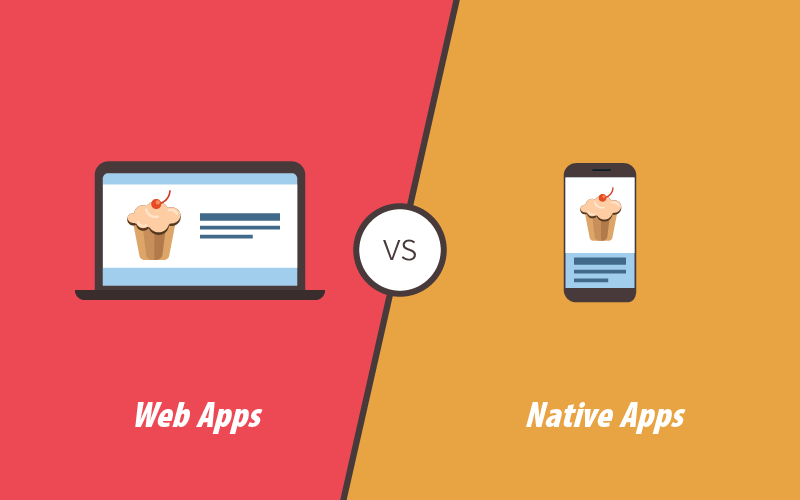If you have an app idea and are learning more about how apps are built, then you’ve likely come across the terms like Native apps and Web apps. But what do they really mean, and what’s the difference? In this article, we’ll explain all. First, here’s a quick summary.
Web apps are software which can run on any device with a modern web browser; they do not need to be installed or built for a specific device. In contrast, Native Apps must be built for a specific device’s operating system, such as iOS or Android, and installed on the device directly.
Let’s explore more details as cover the pros and cons of web apps vs native apps.

Native Apps, What are they?
Native Apps are software built to work directly with a mobile device’s operating system and hardware. Developers write Native Apps for iPhone using either the Swift or Objective-C programming languages, and apps for Android Devices use Kotlin or Java.
With iPhone apps, the iPhone is the hardware, while iOS is the operating system. Together, they make the platform. For an App to run on an iPhone, an iOS Developer’s code must be transformed into machine code that the operating system understands.
A native application can use the full range of device features, including GPS, camera, microphone, vibration, file storage, and push notifications.
Generally, native mobile apps must be downloaded from either Google Play or the Apple App store to run on your mobile device.
Web Apps & Progressive Web Apps
Web apps are built with the same web technologies as websites, HTML, CSS, and JavaScript. This gives them the benefit of being able to run on any device with a web browser. The critical difference between a web app and a website is that web apps process data in a way that’s useful to the end user — for example, converting a PDF or tracking items on your to-do list.
Through the browser, web applications can access the device’s geolocation, camera and microphone, and vibration. But are limited by not being able to send push notifications on iOS. For this reason, many developers use email and SMS notifications instead.
When you read about web apps, you’ll often hear of Progressive Web Apps, PWAs. A PWA takes web apps and kicks things up a notch, improving user experience by making the software less like a website and more app-like.
A progressive web app uses a technology called service workers, which allows the app to perform actions in the background. A service worker is a special container that improves reliability by providing offline access and boosts performance. A PWA can be installed on users’ devices which gives them a link to the app on their home screen.
Pros & Cons of Web Apps vs Native Apps
Native App Pros:
Native Apps provide better performance than web apps, and greater functionality, as they have access to system resources. Another key benefit of native apps is security; the app store must approve all native apps before customers can download them.
Apps built natively also benefit from increased discoverability since the native app marketplaces are huge. The Google PlayStore, for example, has 3,739 apps posted daily, while the Apple App Store has 998 apps posted daily. Developers can then optimise their exposure to these markets using ASO (App Store Optimization).
Web App Pros:
Web apps don’t need to be downloaded or installed since they function in the browser, but PWAs can be ‘installed’ for extra functionality. Building, updating and maintaining web apps is a cinch as there are no mobile platform compatibility issues to worry about or app store approval to await.
Native App Cons:
Native apps have their drawbacks. For one, they’re generally more expensive to build and maintain than web apps. And building pure native apps usually means designing and building the app from scratch for each platform you want to release.
Web App Cons:
Generally, web apps don’t work offline, as they need an Internet connection, although PWAs can work offline. Since web apps run in the browser, their performance is less than native apps. Additionally, web apps lack access to the full feature set available to native apps. Finally, web apps don’t have the discoverability benefit of being listed in the app stores; instead, they need to leverage tactics like SEO.
Final Thoughts
When deciding which type of app to go with for your idea, consider your business needs. Web apps are more accessible for users as they can access them from any device. They are also less expensive to maintain, which makes them a great option for startups. However, web apps have some drawbacks too. They are not as fast as native apps, and they don’t provide the same experience that native apps do, although that gap is narrowing thanks to PWAs.
If you’re looking for some design or development help with your great app idea, please get in contact; we’d love to learn more and see how we can help bring your dreams to life.


